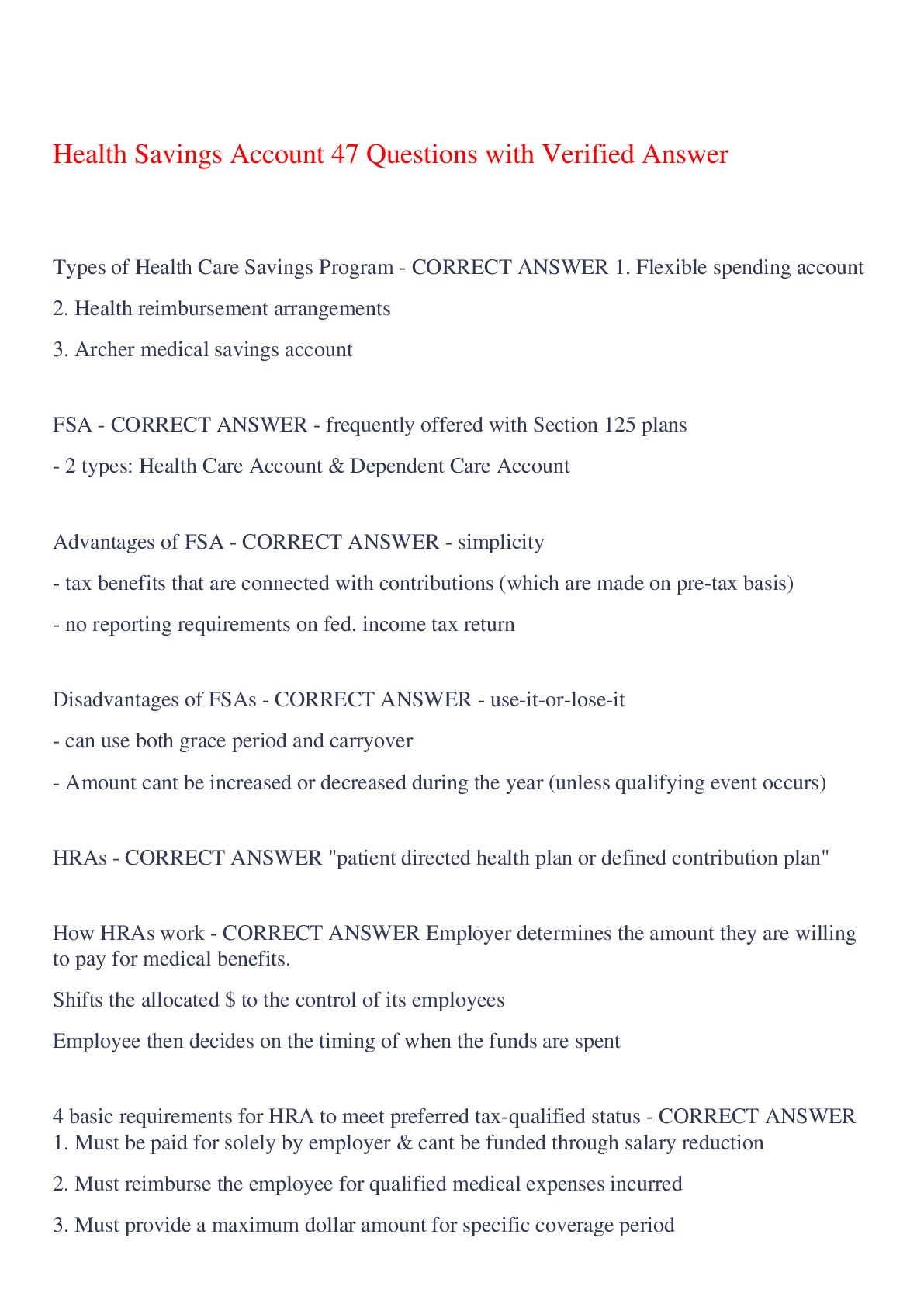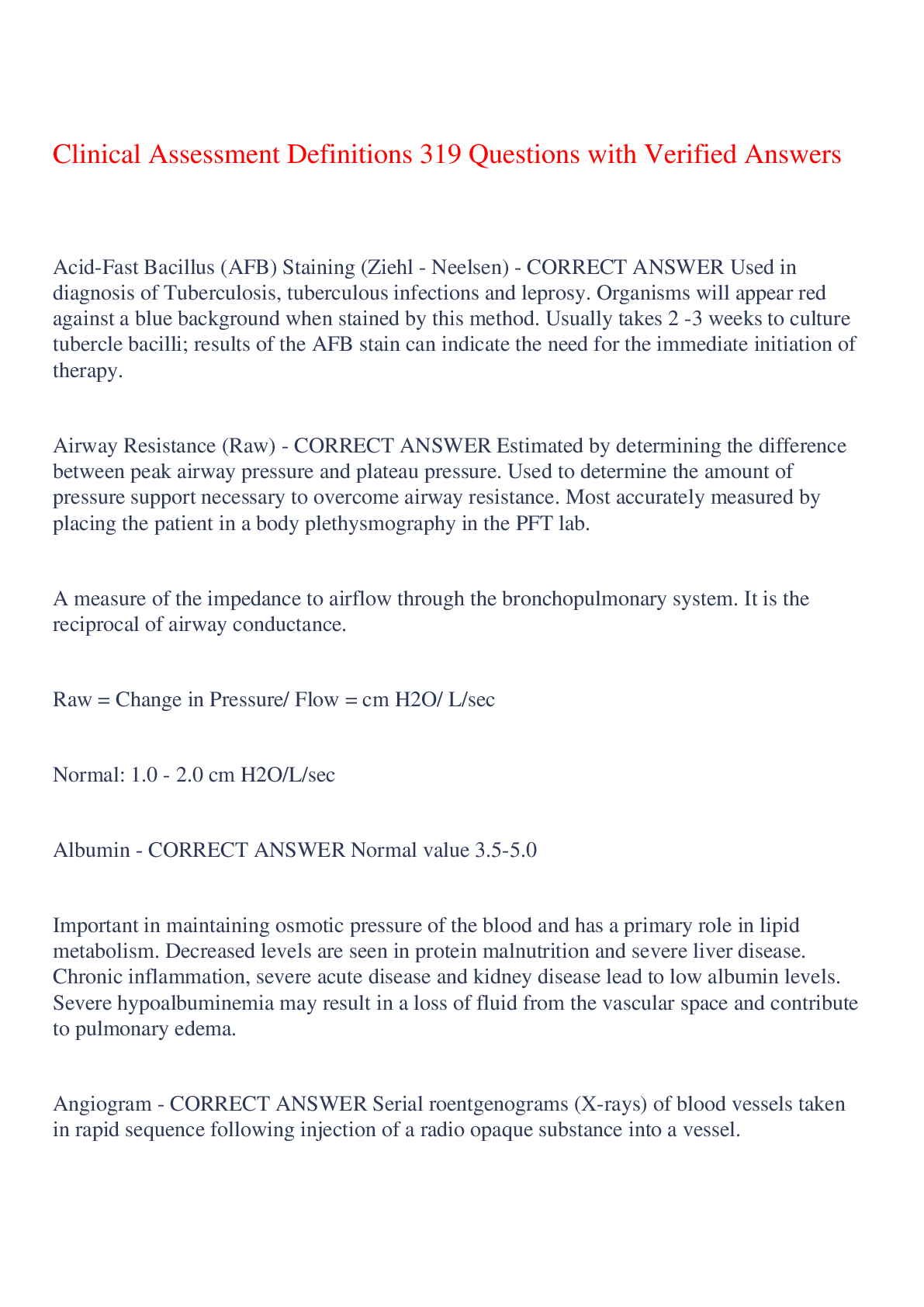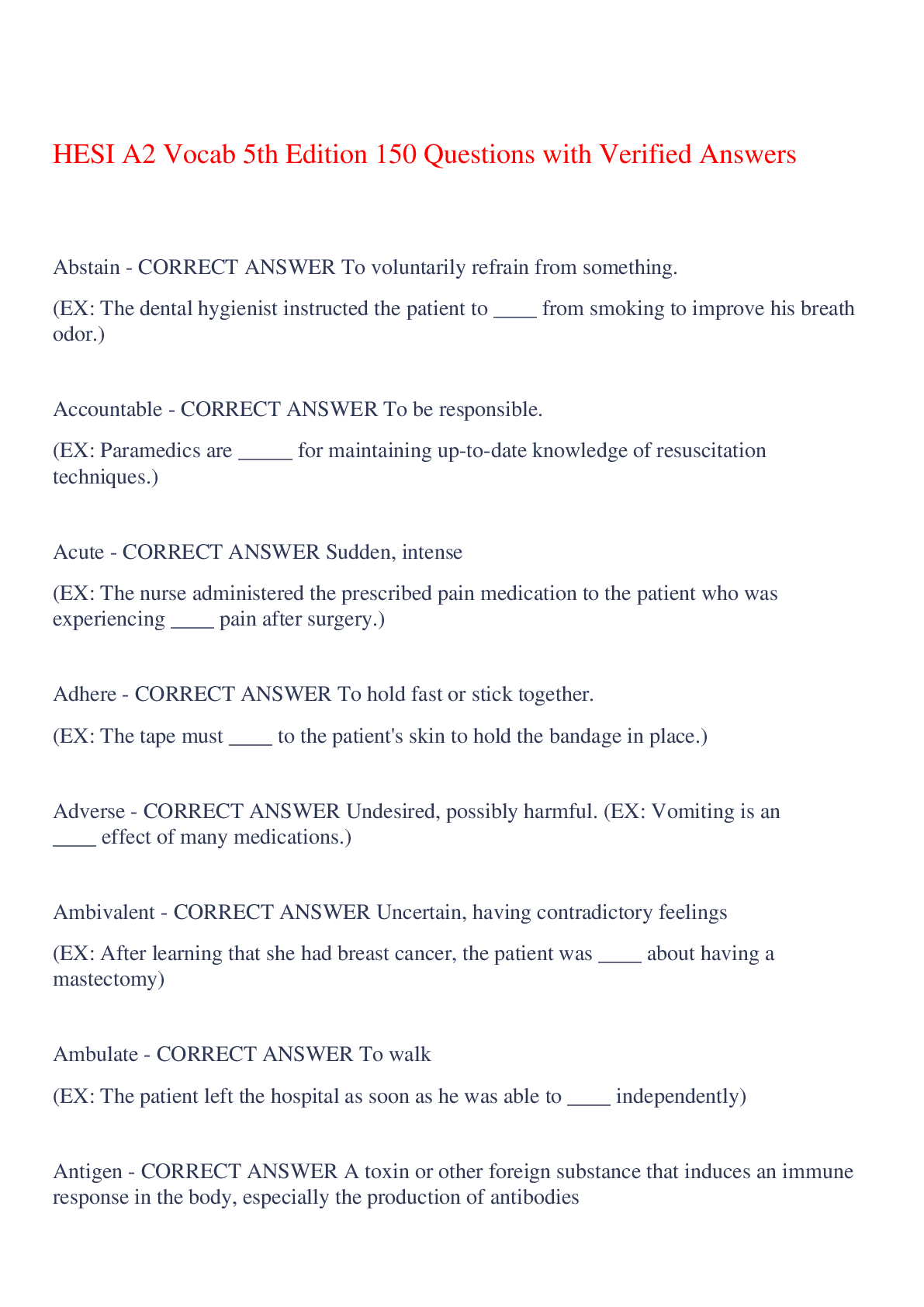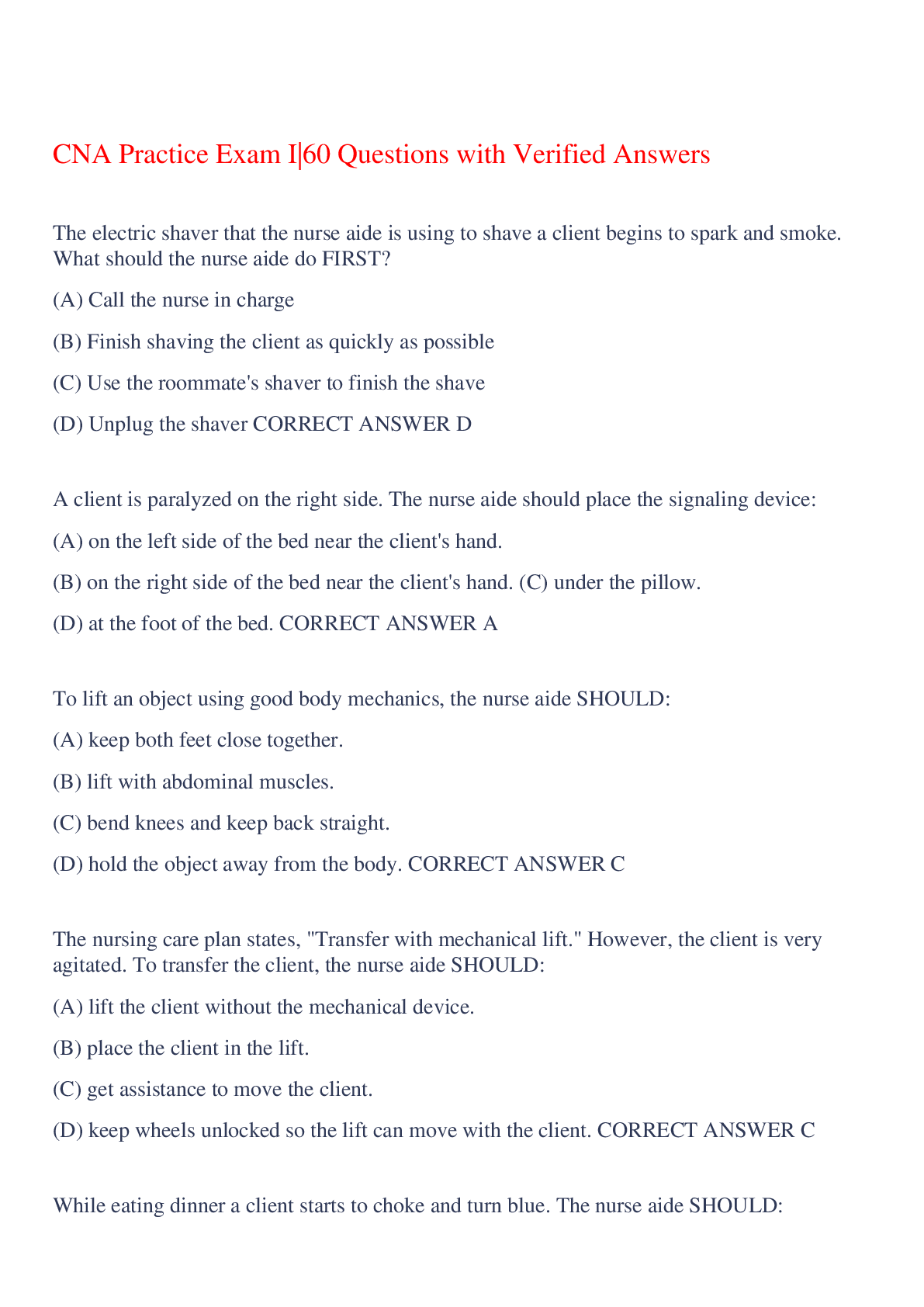Health Care > EXAM > CPH Exam Epidemiology 94 Questions with Verified Answers,100% CORRECT (All)
CPH Exam Epidemiology 94 Questions with Verified Answers,100% CORRECT
Document Content and Description Below
CPH Exam Epidemiology 94 Questions with Verified Answers Epidemiology - CORRECT ANSWER *the study of the distribution and determinants of health and disease in populations. Endemic disease - C... ORRECT ANSWER *habitual presence of disease within a given geographic area Epidemic - CORRECT ANSWER *Occurrence in a community of a group of illnesses of similar nature in excess of what would normally be expected. Amount of disease depends on # susceptible (at risk) and # not susceptible by way of immunization, past disease or genetics. Pandemic - CORRECT ANSWER *worldwide epidemic Outbreak types: Common source - CORRECT ANSWER *group of persons exposed to common agent *point-exposed over a brief period of time *intermittent-exposed over a long period of time. Outbreak types: Propagated - CORRECT ANSWER *spreads gradually from person to person. Outbreak types: Mixed epidemic - CORRECT ANSWER *common source and from person to person. Outbreak Investigation Steps - CORRECT ANSWER 1. Define the epidemic --cases, population at risk, determine attack rate, primary case, secondary case, secondary attack rate. 2. Look for the time-place interactions of cases, persons 3. Look for combinations of variables 4. Develop hypothesis 5. Recommend control measures Attack rate - CORRECT ANSWER *number of people at risk who develop the disease/number of people at risk Primary case - CORRECT ANSWER *the person who gets the disease form the source Secondary Case - CORRECT ANSWER *the person who gets the disease from the primary case. Secondary attack rate - CORRECT ANSWER *person to person spread *number of persons who got sick via the primary case/number of persons exposed to primary case. Incidence - CORRECT ANSWER *measure of risk (new cases) Prevalence - CORRECT ANSWER *measure of the burden of disease in a community (new and pre-existing cases) *point prevalence: at a specific point in time *period prevalence: during a specific period of time. Morbidity - CORRECT ANSWER *the occurrence of disease in populations; the number of cases of a particular disease reported within a particular society and within a particular period of time. Mortality - CORRECT ANSWER *proportion in a population that dies during a specified period. Case Fatality (CF) or fatality rate - CORRECT ANSWER *measures the severity of disease. *it is the ratio of deaths within a designated population of people with a particular condition, over a certain period of time. Primary prevention - CORRECT ANSWER *prevent the disease from occurring (e.g. immunization) Secondary prevention - CORRECT ANSWER *modify the severity of the extent of the disease (e.g. better access to emergency care) Tertiary prevention - CORRECT ANSWER *rehabilitation; measures to prevent reoccurrence of disease. Descriptive epidemiology - CORRECT ANSWER *describes the health conditions and health-related characteristics of populations, typically in terms of person, place, and time. Types of descriptive studies - CORRECT ANSWER *routine analyses of vital statistics, communicable disease reports, other notifiable events. *periodic surveys of health status, knowledge, belief, attitudes, practices, behavior, environmental exposures, and health care encounters. *specialized surveys to establish prevalence of a condition, a characteristic or use of a medical procedure. Analytic epidemiology - CORRECT ANSWER *involves the systematic evaluation of suspected relationships, for example between an exposure and a health outcome. *usually involves the testing of hypotheses Types of analytic studies - CORRECT ANSWER *case-control studies; comparison of people who develop a condition with people who do not *follow up studies: a comparison of people with and without a characteristic in relation to a health related event *Intervention trials; comparison of a subsequent experience exhibited by people to whom a treatment or preventative intervention has been given, to that of people not provided that intervention. Aggregate Data - CORRECT ANSWER *vital statistics *data from government databases *summaries of disease and injury reporting systems and registries *environmental monitoring systems *production and sales data Individual Level data - CORRECT ANSWER *vital events registration *disease and injury reporting systems and registries *national surveys *medical records *questionnaires *biological specimens Type I error (alpha) - CORRECT ANSWER *reject the null hypothesis when it is true. Type II error (beta) - CORRECT ANSWER *do not reject the null hypothesis when it is false. Power - CORRECT ANSWER *probability of detecting a difference if one truly exists, i.e. probability that a study will find a statistically significant difference, when a difference of a given magnitude truly exists. *1-beta Selection bias - CORRECT ANSWER *biases that result from the way study participants are selected from the source population. *this error results when the sample/study participants is/are not representative of the population of interest. Causes of selection bias: - CORRECT ANSWER *self-selection (volunteering) *non response *loss to follow up *choice of an inappropriate comparison group (investigator selection) Control of selection bias - CORRECT ANSWER *this can be controlled in the analysis by identifying factors that are related to subject selection and controlling for them as confounders. Minimizing selection bias - CORRECT ANSWER *if selection bias has occurred in the enumeration of the exposed group, it may be minimized by choosing an appropriate non-exposed comparison group. Information bias - CORRECT ANSWER *a systematic error due to incorrect definition, measurement, or classification of variables of interest. *results from the misclassification of the study participants with respect to disease or exposure status. Non-differential misclassification - CORRECT ANSWER *occurs when the probability of misclassification of exposure is the same for cases and non-cases. Differential misclassification - CORRECT ANSWER *occurs when the probability of misclassification of exposure is different in diseased and non-diseased persons. Sources of information bias: - CORRECT ANSWER *errors in assignment of cause of death *errors and omissions in medical records *false positives or negatives on diagnostic tests Minimization of information bias - CORRECT ANSWER *ensure that the misclassification is non-differential by ensuring that exposure information is collected in an identical manner in cases and non-cases. incidence studies - CORRECT ANSWER *involve an event, which occurs at a particular point in time, rather than a state, which can exist over an extended period of time. incidence rate - CORRECT ANSWER *a measure of disease occurrence per unit population time, and has the reciprocal of time as its dimension. Rate ratio (incidence density ratio) - CORRECT ANSWER *the ratio of the incidence rate in the exposed group to that in the non-exposed group. incidence proportion (cumulative risk/average risk) - CORRECT ANSWER *the proportion of people who experience the outcome of interest at any time during the follow up period. Risk ratio (cumulative incidence ratio) - CORRECT ANSWER *the ratio of the incidence proportion in the exposed group to that in the non-exposed group. Incidence odds - CORRECT ANSWER *the ratio of people who experience the outcome to the ratio of people who do not experience the outcome. Odds ratio - CORRECT ANSWER *the ratio of incidence odds in the exposed group to that in the non-exposed group. Prevalence studies - CORRECT ANSWER *denotes the number of cases of disease under study existing in the source population at a particular time. *enable assessment of the level of morbidity and the population disease burden for a non-fatal condition. Observational studies - CORRECT ANSWER *cohort studies *case control studies *cross sectional/prevalence studies Exposure - CORRECT ANSWER *any factor that is under study, or the presence of a factor in the external environment. Dose - CORRECT ANSWER *the amount of substance that reaches susceptible targets within the body. Cohort studies - CORRECT ANSWER *a cohort is a group of subjects who have shared a particular experience during a particular time span. *the objective of a cohort study is to determine if the incidence of an event is related to a suspected exposure. *rate ratio and risk ratio relative risk - CORRECT ANSWER *ratio of risk in the exposed to that in the unexposed. concurrent/prospective/longitudinal cohort study - CORRECT ANSWER *start now and follow into the future *baseline exam, methods, follow up can be planned *Quality control measures can be implemented *disadvantages: time and cost Non-concurrent/historical/retrospective cohort study - CORRECT ANSWER *cohort assembled in past, based on existing records *follow up usually to current time for outcome *useful in occupational studies *advantage: less expensive and less time consuming than concurrent *disadvantage: existing records may have been limited or biased. Follow up may be difficult. Case-Control studies - CORRECT ANSWER *compare the odds of past exposures to an agent/factor between cases and controls. *odds ratio Case-based studies (case control type) - CORRECT ANSWER *all cases occurring at some point in time *control selection can be difficult Nested Case-Control Studies - CORRECT ANSWER *a case control study nested in a cohort study *controls selected either at base line or at the time the case occurs *advantages: data on exposure are obtained before disease develops; possibility of recall bias is thus eliminated; less expensive than expanding the analysis to include the entire cohort; here the OR is a statistically unbiased estimate of relative risk. Matching - CORRECT ANSWER *used to make cases and controls as similar as possible with regard to potential confounding factors. Individual matching - CORRECT ANSWER *one or more control individually matched to a case from an eligible pool Frequency matching - CORRECT ANSWER *a group of controls so the distribution of characteristics in the cases and controls is similar Minimum Euclidean Distance Measure - CORRECT ANSWER *match closest eligible person to the case. Advantages of Matching - CORRECT ANSWER *may be the only way to control confounding *when limited to strong confounders, matching increases statistical power of the study *straightforward way to obtain a comparable control group Disadvantages of Matching - CORRECT ANSWER *the association between the matching variable and outcome cannot be assessed *requires the use of special analytic techniques *overmatching--if matching variable is strongly correlated with the variable of interest--may eliminate ability to see a real association *if match variables are weak confounders, no statistical power is gained *matching is irreversible *residual confounding occurs if you match continuous variables by category Cross Sectional/Prevalence Studies - CORRECT ANSWER *a snapshot of a cohort regarding information on disease and exposure at a single point in time. *tell us the prevalence and the association. randomized clinical trial - CORRECT ANSWER *an experiment used to test the efficacy or effectiveness of healthcare services. field trial - CORRECT ANSWER *a test of the performance of some new product under the conditions in which it will be used Community Intervention - CORRECT ANSWER *intervention on a community-wide basis, i.e. fluoridation Cluster randomized trials - CORRECT ANSWER *prevention/field trials to groups rather than individuals Case-cross over design - CORRECT ANSWER *cases serve as their own control *value for some variable assessed or collected at the time of case determination is compared to value of variable at some previous time. *Assumptions are that the (i) exposure effects are not cumulative, (ii) the disease has no pre-clinical stage that could affect exposure *issue: potential for recall bias Characteristics of RCTs and Field Trials - CORRECT ANSWER *random assignment *blinding *placebo *gold standard for evidence. Precision (reliability) - CORRECT ANSWER *reproducibility *random error will occur in any epidemiologic study. *increasing sample size, so that the precision of the effect estimate will be increased, would be the most effective way of reducing random error. Validity (accuracy) - CORRECT ANSWER *absence of bias *systematic error occurs if there is a systematic difference between what the study is actually estimating and what it is intended to estimate. *increasing the sample size does NOT reduce the chance of this error. Quality assurance - CORRECT ANSWER *activities to ensure quality of the data before data collection. Quality control - CORRECT ANSWER *efforts to monitor and maintain the quality of data during the conduct of the study Confounding - CORRECT ANSWER *a situation in which a non-causal association between a given exposure and an outcome is observed as the result of a third variable or distortion of an apparent effect of an exposure on risk brought about by the association with other factors that can influence outcome. A confounding variable must be: - CORRECT ANSWER *related to both the exposure and outcome under study *not an intermediate variable in the relationship Positive confounding - CORRECT ANSWER *when the crude RR/OR is further from 1.0 than the adjusted ratio. Negative confounding - CORRECT ANSWER *when the crude RR/OR is closer to 1.0 than the adjusted ratio Qualitative confounding - CORRECT ANSWER *when moving from an RR/OR that is at either side of 1.0 Control of confounding prior to data collection: control in the study design - CORRECT ANSWER *random collection *individual matching *frequency matching Control of confounding after data collection: control in the analysis - CORRECT ANSWER *direct adjustment; indirect adjustment; mantel-haenszel; regression techniques Interaction - CORRECT ANSWER *occurs when the incidence of disease in the presence of two or more risk factors differs from the incidence expected to result from their individual effect. Synergistic (positive) interaction - CORRECT ANSWER *if the presence of the effect modifier accentuate the effect of the exposure of interest (categorical) or the outcome differ depending on the level of the effect modifier (continuous) Antagonistic (negative) interaction - CORRECT ANSWER *if the presence of the effect modifier accentuates the effect of the exposure of interest (categorical) or the outcome differs depending on the level of the effect modifier (continuous) Quantitative interaction - CORRECT ANSWER *interaction in the same direction from the crude RR/OR by stratum specific analysis, but the association still varying form stratum to stratum Qualitative interaction - CORRECT ANSWER *interaction in the opposite direction (cross-over) from the crude RR/OR by stratum specific analysis, but the association still varying from stratum to stratum. Interpretation of Studies: Temporality - CORRECT ANSWER *the cause must precede the effect Interpretation of Studies: Specificity - CORRECT ANSWER *specificity of the effect is important in assessing possibility of biases Interpretation of Studies: Consistency - CORRECT ANSWER *this is demonstrated by several studies giving similar results. Statistically it corresponds to homogeneity across studies. dose-response relationship - CORRECT ANSWER *occurs when changes in the level of exposure are associated with changes in the prevalence or incidence of the effect that one would expect form biologic considerations. *the absence of an expected dose-response relationship provides evidence against a causal relationship, while its presence narrows the scope of biases that could explain the relationship. Stages in the Data Analysis - CORRECT ANSWER 1. Hypothesis stage 2. Data set development stage 3. Analysis Stage 4. results and conclusion stage Hypothesis Stage - CORRECT ANSWER *define general hypothesis *define outcome variable *define exposure or risk factor variables *recognition of study design needed to test hypothesis *define specific hypothesis to be tested *f working from an existing data set, can the hypothesis be tested adequately? Data Set Development Stage - CORRECT ANSWER *data set description and formation of analytical data set *verify data in data set *Examine variables. Analysis stage - CORRECT ANSWER *develop an analysis strategy *estimate the maximum number of variables to be included in any model *select a model building strategy for assessing interaction and confounding *conduct analyses Results and conclusions - CORRECT ANSWER *examination of results; interpretation of results *results evaluation *limitations of study and analysis *conclusion *further analyses [Show More]
Last updated: 8 months ago
Preview 1 out of 12 pages

Reviews( 0 )
Document information
Connected school, study & course
About the document
Uploaded On
Aug 25, 2023
Number of pages
12
Written in
Additional information
This document has been written for:
Uploaded
Aug 25, 2023
Downloads
0
Views
71



































